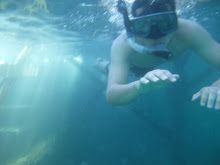breaking trough the polar ice caps
Icebreaker is a purpose built ship designed to navigate trough the ice covered waters.An icebreaker had a different traits from other vessels which is ice strengthened hull, ice clearing shape and much more power to push the vessel trough the ice-covered water.
It is used to keep trade routes navigable by other vessels in the polar region or in areas where seasonal ice conditions exists.Some icebreakers are also polar research vessels engaged in scientific and oceanographic researches in the polar regions.Icebreakers like the RV Polarstern are deeply involved in scientific researches.
the arktika class icebreaker riding over the ice to open up shipping lane during winter season
The combination of momentum and power drive the vessel on to ice and breaking it under the immense weight of the vessel.The ship had specially designed hull to direct the broken ice around or under to keep it away from the ship propeller or propeller shaft thus clearing the debris out from the ship path.
Double hull constructions and watertight compartments protects the icebreaker from taking in water in case of hull breach with the hull thickness is greater than normal seagoing.This is most notable at the bow,stern and along the vessel waterline.
the strengthened bow of an icebreaker differs from normal vessels
Azimuth Podded Propulsion (azipods) are a norm in new type of icebreakers where these propulsion systems give the ship a much greater manoueverability and increase fuel efficiency.This has permitted the vessel from the reliance of rudder.
RV POLARSTERN
RV Polarstern of the Alfred Wagener Institute for Polar and Marine Research,Bremerhaven
USCGC HEALY (WAGB-20)
USCGC Healy of the United States Coastguard
| Displacement: | 16,000 tonnes |
| Length: | 130 m |
| Beam: | 25 m |
| Ice class: | 1.4 m @ 3 kn (5.6 km/h; 3.5 mph) continuous 2.4 m backing and ramming |
| Propulsion: | Diesel - Electric |
| Speed: | 17 knots |
| Complement: | 76 crew, 50 scientists |
| Aircraft carried: | 1999–2005: 2 × HH-65A Dolphin helicopter 2005–present: Helicopter support is performed by a National Science Founder contractor. |
The United States Coastguard comissioned the WAGB-20 in year 1999 joining another two USCG icebreakers.USCGC Healy is a research icebreaker capable of conducting coastguard duties including logistics, search and rescue, escort duties, enviroment protection and enforcement of laws and treaties.
The Coastguard icebreaker cum cutter is designed to break 1.5m of ice continuously at three knots and can operate in temperatures as low as −45 °C.
50 лет Победы (50 YEARS OF VICTORY) - ARKTIKA CLASS NUCLEAR ICEBREAKER
50 Let Pobedy or 50 Years Of Victory owned by Murmansk Shipping Company
| Displacement: | 25840t |
| Length: | 159.60 m |
| Beam: | 30.00 m (28.00 m at the waterline) |
| Draught: | 11.08 m |
| Depth: | 17.2 m |
| Ice class: | LL1 |
| Installed power: | 2×27.6 MW (37,012 hp) nuclear reactor, model "TGG-27,5 OM5" |
| Propulsion: | 3×17.6 MW (23,602 hp) electric propulsion motors |
| Speed: | up to 21.4 knots (39.6 km/h) |
| Endurance: | 4 years |
| Capacity: | 128 passengers |
| Crew: | 140 crew members |
The last of the Arktika class nuclear icebreaker, the 50 Years of Victory is the most powerful icebreaker ever built in history with nuclear reactor powering up her propulsion systems. Built in St. Petersburg the icebreaker is designed to break through ice up to 2.8 meters thick with crew capacity up to 140 personnel.
Other ships in the class are NS Arktika(Arctic),NS Sibir(Siberia),NS Rosiyya(Russia),NS Sovyetskiy Soyuz(Soviet Union) and NS Yamal(End of The Land).
KAPITAN KHLEBNIKOV
Kapitan Khlebnikov owned by Far East Shipping Company(FESCO)
| Displacement: | 12,288 tons |
| Length: | 122.50 m |
| Beam: | 26.50 m |
| Draught: | 8.50 m |
| Ice class: | KM * LL3 [2] А2 passenger |
| Installed power: | Main engines: 6 diesel sets producing 24,200 horsepower (18.5MW) |
| Propulsion: | 3 twin DC electric motors each turning a 22m long propeller shaft to which is attached a 4 bladed 4.3m diameter propeller with hardened steel blades. Blades can be changed at sea in the event of damage. |
| Speed: | 14 knots in open water Max speed: 19 knots |
| Complement: | Guests: 108 |
| Crew: | Staff & Crew: 70 |
| Aircraft carried: | Two helicopters are carried to help with navigation in ice and for tourist trips. |
| Aviation facilities: | Hangars |
Kapitan Khlebnikov is a Russian icebreaker built during the Soviet era by Wartsila in Helsinki, Findland. She is powered by conventional diesel engine and was refitted into tour ship in 1990. The ship is capable to accomodate up to 108 passenger with facilities of 54 cabins and suites, with 2 dining rooms, a lounge and bar a heated indoor swimming pool, exercise room and sauna, theatre-style auditorium and shop.
The hull thickness is 45mm at the ice skirt and 25-35mm elsewhere. Friction between the ship and the ice is reduced by a polymer-paint coating at the level of the ice skirt. An air bubbling system helps ice breaking. Air can be forced under pressure from 2m above the keel from the bow to half way down the ship.
-come to sea and see for yourself-














No comments:
Post a Comment